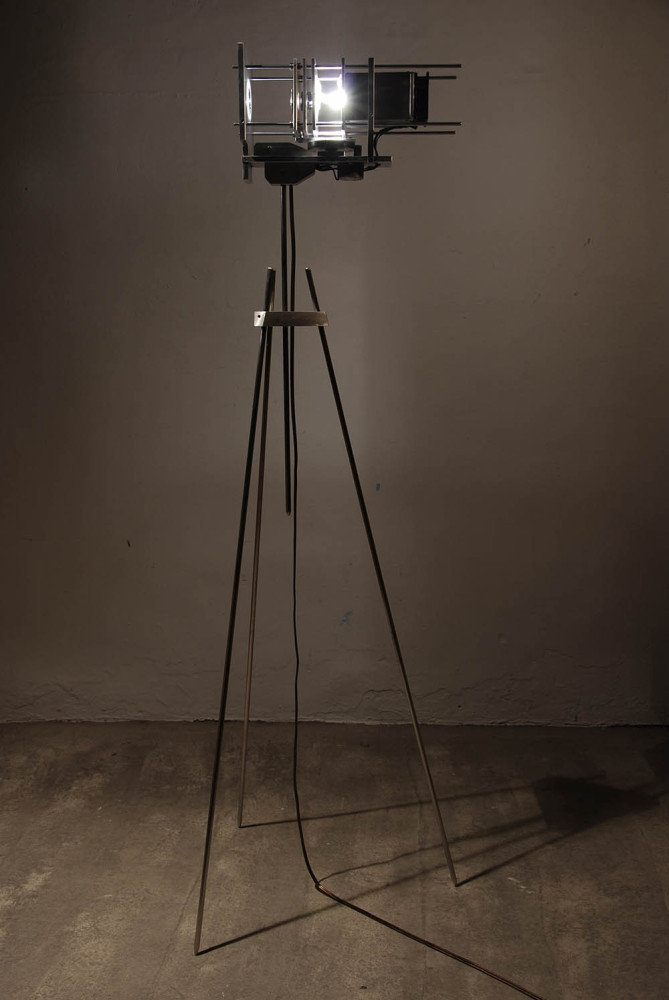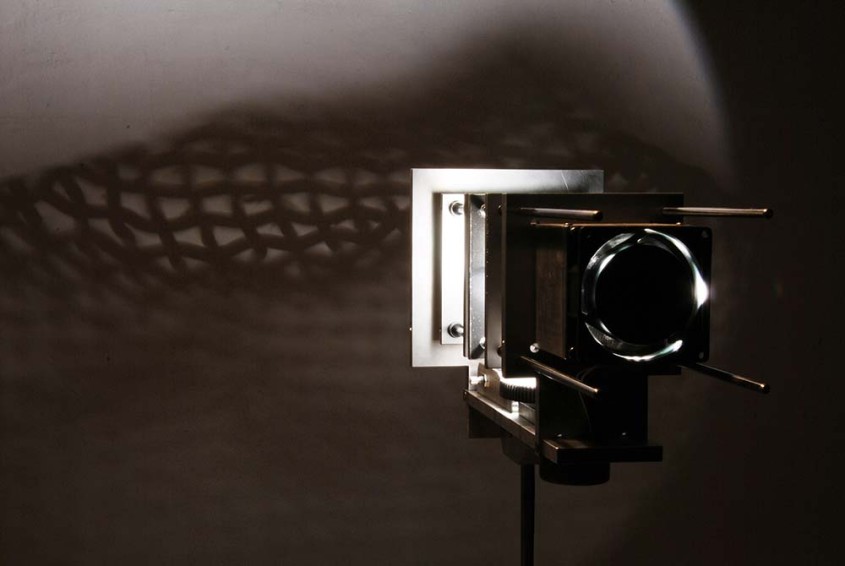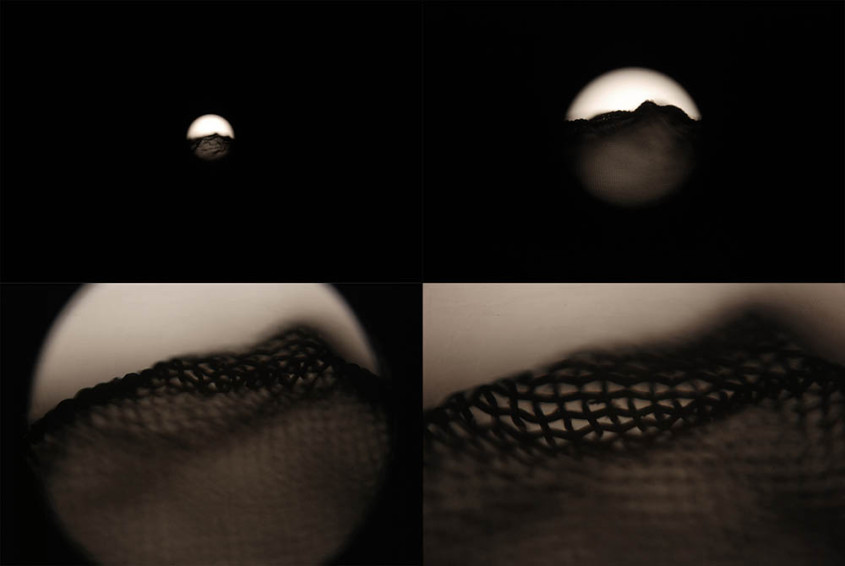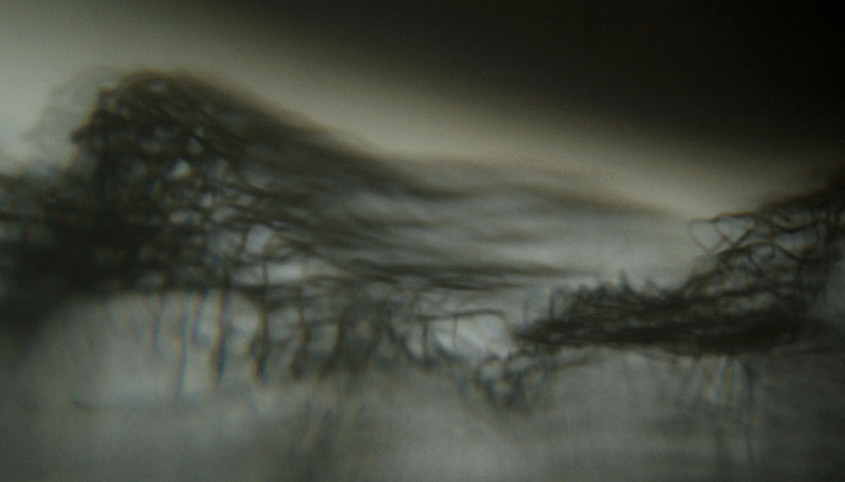
Wire V
Metal, glass, motor
Dimensions variable
2018
鐵絲網 V
金屬、玻璃、馬達
尺寸視空間而定
2018
The wire series originated in 2003, and is based on the structure of the Magic Lantern slide projection work, through a mechanical control to repeatedly adjust the focal length to transform a regular piece of wire mesh into a moving image of a dynamic Chinese landscape (Shanshui); to explore how images change the way we see and imagine the outside world. Every single piece of this series of work provides different angles into this proposition. In Wire V, an episcope (Opaque Projector) is used as the imaging principle. The strong light illuminates the mesh wire, and is directed through a large camera lens focusing the image, which is then projected as an exquisite image.
With the rapid development of digital technology, the requirement for image resolution continues to increase, from photography, video equipment to display devices. Format from full HD, 2K, 4K or even 8K in the future, exponentially increases every few years. In addition to the promotion of the commercial market, I am curious about the deeper desires that drive the endless pursuit of reproduction far beyond what the body can sense. Or we just change a way in which to pursue a space that is feasible, hopeful, visitable and livable.
鐵絲網系列開始於2003年,以基本的幻燈投影(Magic Lantern)為架構,透過機械控制的反覆調焦,將一片平凡的鐵絲網轉換為充滿山水意境的動態影像,借此探討影像如何改變了我們的觀看,和想像外在世界的方式。系列中的每件作品,各自由不同的角度切入這個命題。鐵絲網五中,使用實物投影(Opaque Projector)的成像原理,將強光照射在鐵絲網上,透過大型相機的鏡頭聚焦成像,投射出鉅細靡遺的影像。
隨著數位技術的快速發展,我們對於影像解析度(Image resolution)的要求不斷提升,從攝影、錄影器材到顯示設備,格式由full HD、2K、4K、甚至到未來的8K,每隔幾年就以倍數成長,除了商業市場的推動,我好奇的是更深層的欲望,驅使人類不停追求再現(Representation)的極致,早已遠超過身體所能感知的真實。
又或許我們只是換了個方式,追尋那片可行、可望、可遊、可居的一方天地。



Wire IV
Metal, glass, motor
Dimensions variable (projector40cmL x 16cmW x 24cmH)
2009
鐵絲網 IV
金屬、玻璃、馬達
尺寸視空間而定 (機具40cmL x 16cmW x 24cmH)
2009
The sense of distance in image is the theme explored in Wire IV.
Only image-recording apparatus can see things by zooming in or out. It creates a “fictional sense of distance” that is detached from people’s position, distance, and perspective in space. In the wide-angle shot, people seemingly get far away from nearby object, indulging in the fictional wide space and alienation. In the telephoto shot, we appear to be watching and peeping closely without the danger of close encounters. The image changes our way of looking at the world and reconstructs out perception of reality. It gave us unprecedented freedom with a minor side effect ——— it’s hard to remember where we stand when looking at the world.
影像的「距離感」是鐵絲網IV 探討的主軸。
變焦(zoom)是一個純然影像機具的觀看邏輯,造成了一種「虛構的距離感」,跳脫了人在空間中觀看的位置、距離、和視角。在廣角的影像中使人彷彿可以抽離於身邊近在咫尺的事物,沉醉於杜撰的遼闊與疏離;在長鏡頭的影像中使人保有一種狀似親密的旁觀窺伺,隔離了近距離接觸的危險。影像轉換了觀看世界的方式,也重新建構對於真實的認知,賦予了人類前所未有的自由,只不過有個小小的副作用——再也難以想起,究竟站在何處看這世界。


Wire III
Metal, glass, acrylic
Dimensions variable
2007
鐵絲網 III
金屬、玻璃、壓克力
尺寸視空間而定
2007
A projector at the center of a circular space starts to revolve slowly and to scan the wall with a bright light that exposes images in the space (a little like a lighthouse sweeping over the scenery and liberating it from darkness). Both the slow speed of the revolving projector and its sound slowly increase, and the images and light beam in the space start to flicker randomly. As the increasing speed reaches its limit, the flashing sensation lessens somewhat, the movement stabilizes and finally creates a continuous and calm ray of light revealing the surrounding images on the walls. After a period of time, the whole apparatus slows down and then starts again.
Generally speaking, the piece attempts to explore the concepts of speed, space, and perception.
環型的空間中央,放置著投影機具,由靜止啟動緩慢的旋轉,投影在牆面的光區如同掃描揭露著環繞四週的影像空間(有點像燈塔掃過黑暗,釋放出景物的感覺);旋轉的速度逐漸加快,機具的聲響漸漸增大,空間中的光線及影像亦愈趨閃爍不定;加快到極速時閃爍感慢慢緩和,運動趨於穩定,最終變成整片平靜的光線,影像在環場牆面上展開。一段時間後,速度漸慢,週而復始。
大致是一個關於速度、空間、和身體感的嘗試。

Wire II
Metal, glass, acrylic
Dimensions variable
2003
鐵絲網 II
金屬、玻璃、壓克力
尺寸視場地大小而定
2003
As I reviewed the artist statement for Wire I, I thought the second version should not be very different so I wouldn’t need to write redundant words. However, as I made the mechanism, I gradually felt I was learning something from the interaction of forms and ideas. It seemed I still had something to share after all.
The core concept of Wire II is simply putting the infinite space of an image side by side with a spinning wheel of wire mesh material. The center of the creative process gradually shifted from the image to the mechanism and the relationship between them. The mechanism has the functions of producing the image and exhibiting its structure while suggesting a certain symbolism or a metaphor.
Compared with Wire I, the new version with a roll of wire mesh material has a different light source and a new set of lenses. To make an analogy, if the previous piece is like the foggy and heavenly atmosphere in Chinese landscape painting of Southern Song Dynasty, perhaps Wire II resembles the magnificent mountains and rivers in the painting of Northern Song Dynasty. It is probably dangerous to talk about my work in terms of the characteristics of Chinese ink painting at the risk of sloppy conceptualization. Nevertheless I have to admit that my idea for the space of image was inspired by the traditional Chinese painting scroll.
As I explore the possibilities of the space of image and study about mechanisms, sculpture, installation art and more, along with the “East” in the back of my mind, it seems the story of the Wire series will go on and on.
回顧《鐵絲網》的創作自述,本想新作應該換湯不換藥,也就不需要再多說廢話;但隨著機具的製作,形式和觀念的相互作用下,漸漸覺得有所發現,似乎還有點心得提一提。
《鐵絲網II》的核心概念,只是單純的想並置一個無限深入的影像空間,和一圈單調的在原地循環輪轉的鐵絲網。創作的重心逐漸由影像轉移到機具,以及兩者間的關係;機具除了功能性的產生影像和暴露自身結構外,還隱含的某種象徵或隱喻。
伴隨著光源、鏡片組的調整,和一圈鐵絲網,影像的風格與前作迥異,打個比方來說,如果前作的視覺風格如同南宋山水畫中煙嵐縹緲的情境,《鐵絲網II》也許更近於北宋時期的大山大水。也許用水墨情境,意象來談自己的作品太過危險,可能會被概念化的草率對待,不過還是要坦承,對影像空間的構思,最初來自傳統水墨裝裱型制中的「捲軸」。
拼湊著影像空間的可能性,機具的探討、雕塑、裝置⋯⋯等的粗淺認識,再加上心底老是隱隱作祟的「東方」,這故事似乎還要絮絮叨叨的說個沒完。
Wire I
metal glass acrylic
dimensions variable
2003
鐵絲網 I
金屬 玻璃 壓克力
尺寸視場地大小而定
2003
The structure of projector is similar to that of a slide projector.The greatest difference is that the imaging magnifier in front will constantly move back and forth and change the focal length within a range of 10 cm.When the projected object(the wire netting) is in focus,the sharply focused parts keep shifting,suggesting a wandering search for something.With the changing focal length,the image keeps disappearing and reappearing. I spent a lot of time thinking what kind of projected object and form could best produce this effect.I finally decided on……wire netting or a certain kind of landscape.
The regular,monotone form of wire netting and its cold industrial material rather match the projector.At the same time,it is flexible and formable.Each folding will leave behind some trace.
It reminds me of the feeling that xuan paper gave me when I did ink painting.
The human trace left behind contrast with the coldness of the material.
The small wire netting of some 10 sq. cm.(the actual area being projected is even smaller) form a strong contrast with the image being projected.To me,it is like an allegory about media: the development of media constantly changes our way of seeing the world and our attitude towards reality.The projector modifies the image of the wire netting and creates a new space for the projection of meaning.But in the end, the work seems to be telling an ancient story.
投影器的結構大致與幻燈機相同,最大的差別在於前方的成像放大鏡反覆的前後運動,在10公分的範圍內不斷改變焦距,而被投影物(即鐵絲網)位於焦點上而清晰的位置亦隨之改變,好像不停的在來回搜尋、徘徊般,在焦距變化中,影像幻滅、消逝、被穿透,而又重生、再現。
花很久的時間思索和嘗試,究竟什麼樣的被投影物和造型最能點出這樣的感受,最後決定的是——鐵絲網和某種山水情境。鐵絲網規矩、單調的造型,冰冷、工業的材質感,與整個投影器頗為搭調,但其具有彈性和可造型的特點,每次摺疊都會紀錄下某些痕跡,很像之前做些水墨時,宣紙給我的感覺,一筆一筆都被記憶下來,增添了某些令人懷念的手感,對應整體材質感的冰冷。
不過十多公分見方的小鐵絲網(實際被投影初的範圍更小),和透過投影器所呈現出的影像,成為強烈的對比,對我來講它也像個關於媒體的寓言:媒體的發展,不段轉變我們看待世界的方式和看待真實的態度,像投影器轉換了鐵絲網的影像,賦予一個可以投射精神的新的空間。不過,整件作品卻好像到過頭來,說一個更古老的故事。